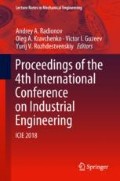Abstract
This paper discusses the predictive modeling of a scribing process. The diamond tool geometry is important for this process. As a prototype for the diamond tool, a four-sided pyramid is taken. Some minor changes are made in its geometry in purpose to make the modified tools. The tool geometry is a factor which affects greatly the quality of a final product, its forming, and overall efficiency of the scribing process. Scribing a brittle sheet with the modified tool is studied via parametric finite element modeling (FEM) with aid of the ANSYS software package for computer-aided engineering. The heterogeneous mesh is generated using solid finite elements with a quadratic form function. To obtain more precise simulation and decrease singular effect under force loading conditions, the contact elements and increased density of knots near the tooltip are added in this mesh. The modified variants of the tools are developed to provide a necessary groove quality on a brittle material surface regardless of movement direction. Finally, the algorithm and the corresponding program module for the parametric solution have been created using internal ANSYS APDL programming language. The computation results sufficiently agree with the experimental data obtained in this work and earlier. The calculated stress intensity in the sheet along the normal direction to the surface has large value up to 15 μm from cutting tool tip and decreases more sharply on the surface than in the cross section. So, the approach presented in this paper helps to understand the cutting process and improve machining technology of brittle materials.
Access this chapter
Tax calculation will be finalised at checkout
Purchases are for personal use only
References
Ogorodnikov IN, Kruzhalov AV et al (1999) Luminescent properties of crystalline lithium triborate LiB3O5. Phys Solid State 41(2):197–201
Ogorodnikov IN, Poryvay NE et al (2011) Thermally stimulated recombination processes and luminescence in Li(6)(Y, Gd, Eu)(BO(3))(3) crystals. Phys Solid State 53(2):263–270
Mostofa MG, Park CI et al (2013) AFM probe based nano mechanical scribing of soda-lime glass. J Manuf Process 15:625–634
Torabi AR, Campagnolo A et al (2015) Local strain energy density to predict mode II brittle fracture in Brazilian disk specimens weakened by V-notches with end holes. Mater Des 69:22–29
Lina J, Cheng M (2014) Investigation of chipping and wear of silicon wafer dicing. J Manuf Process 16:373–378
Chen C, Luan Q et al (2015) Ridge waveguides in Nd: ABC3O7 disordered crystals produced by swift C5 + ion irradiation and precise diamond dicing: broad band guidance and spectroscopic properties. Opt Laser Technol 68:84–88
Ogorodnikov AI, Tikhonov IN (2010) Simulation of defect zones in scribed silicon wafers. In: Materials science and engineering: IOP conference series 15: AN 012046
Witzendorff P, Stompe M (2014) Dicing of hard and brittle materials with on-machine laser-dressed metal-bonded diamond blades. Precis Eng 38:162–167
Ogorodnikov AI, Zhukov YuN (2015) Cutter for splitting brittle sheet blanks. Russ Eng Res 35(6):413–416
Xiao G, To S (2015) Molecular dynamics modelling of brittle–ductile cutting mode transition: case study on silicon carbide. Int J Mach Tools Manuf 88:214–222
Blackley W, Scattergood R (1991) Ductile-regime machining model for diamond turning of brittle materials. Precis Eng 13:95–103
Suzuki H, Okada M (2013) Development of micro milling tool made of single crystalline diamond for ceramic cutting. CIRP Ann Manuf Technol 62:59–62
Krauthammer T (2008) Modern protective structures. CRC Press, Taylor & Francis Group
Author information
Authors and Affiliations
Corresponding author
Editor information
Editors and Affiliations
Rights and permissions
Copyright information
© 2019 Springer Nature Switzerland AG
About this paper
Cite this paper
Ogorodnikov, A.I., Zhukov, Y.N. (2019). Predictive Modeling of Scribing Brittle Material Using Diamond Tool with Improved Geometry. In: Radionov, A., Kravchenko, O., Guzeev, V., Rozhdestvenskiy, Y. (eds) Proceedings of the 4th International Conference on Industrial Engineering. ICIE 2018. Lecture Notes in Mechanical Engineering. Springer, Cham. https://doi.org/10.1007/978-3-319-95630-5_200
Download citation
DOI: https://doi.org/10.1007/978-3-319-95630-5_200
Published:
Publisher Name: Springer, Cham
Print ISBN: 978-3-319-95629-9
Online ISBN: 978-3-319-95630-5
eBook Packages: EngineeringEngineering (R0)

